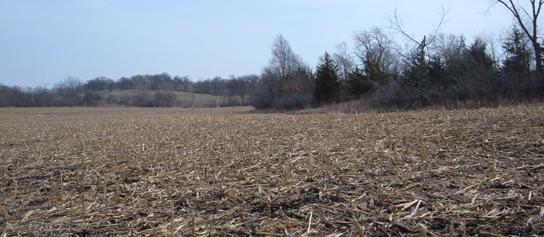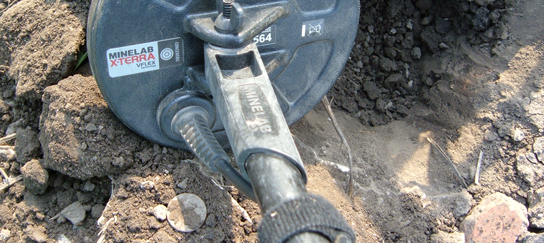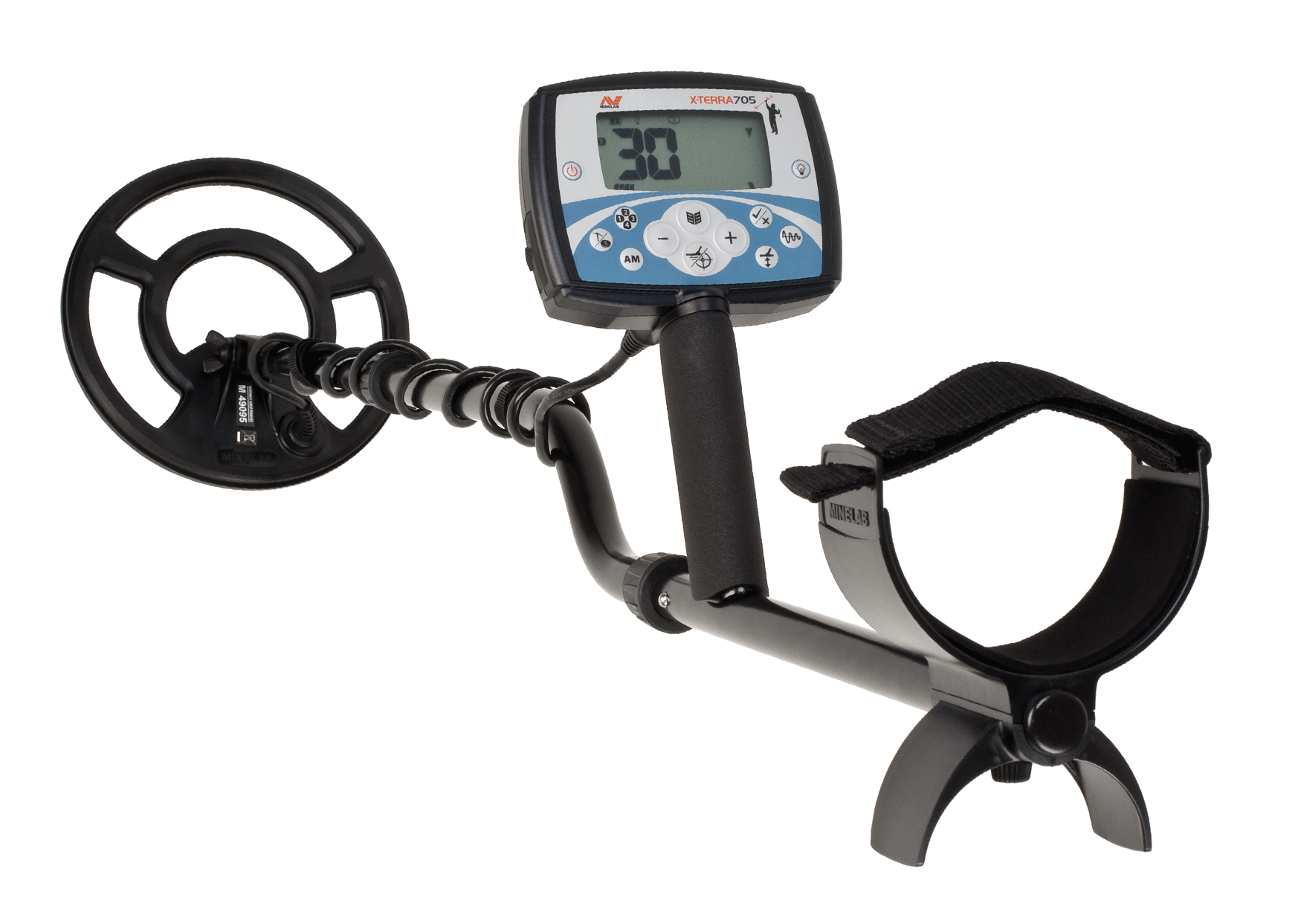With "old" being a relative term, I hunt for old coins at old sites. The part of the world that I live in wasn't settled until the mid 1850's. So finding coins older than 1900 is considered to be a good hunt. Many of my favorite spots to detect are old homesteads and farm sites. With the houses and out buildings long gone, to the passerby, most of these places look like any other corn field in this part of the Country. Pieces of brick, stone, glass and pottery are some of the things that I look for when wandering across these corn fields. And when I start hearing the low tones produced by nails and other "farm trash", I know I'm getting close to where I want to be. Unfortunately, even though these pieces of deeply buried iron are a good indicator of where the buildings once stood, their occasional "wrap around" high tones can cause a lot frustration. I'd venture to say that there isn't one among us who hasn't dug a piece of deeply buried iron or an old rusty nail, expecting it to be a coin. Now, I'm not going to tell you that the method I use to help eliminate these targets will keep you from digging all of them. But I will tell you that the X-TERRA has the ability to identify most of these "trashy" targets, even when providing an initial "keeper" tone. It’s just a matter of properly setting up your X-TERRA, knowing how to work the coil and listening to what the detector is telling you. And it is for those "wrap around" targets that I have written this short article.

This process is fairly simple… but to implement it, your X-TERRA must be capable of operating in the Multiple Tone mode (X-TERRA 305, X-TERRA 505, X-TERRA 70, or X-TERRA 705). And you must be using zero discrimination (or All Metal mode). Although I've found that the 9-inch Concentric coil at 3kHz provides the most easily distinguishable low tones on deeply buried iron, all of the coils will do it to a certain degree.

When you first get the "hit" on what sounds like a good target, slowly “X” over the target from several directions. Much of the deep iron will produce broken or choppy signals when working your coil around the target. If the audio response locks on a high tone, make a mental note as to where the strongest target signal is coming from so you can center the target under the coil. Once you get the target centered under the coil, continue wiggling the coil back and forth over the target while slowly working the coil closer toward you. As the target leaves the front edge of the field of detection, listen even more intently to the tones. If the audio tone is high and drops off suddenly, get out your digging tool and retrieve your coin. Here is a short audio clip of the sound produced by coins.
If the audio tone starts out high, then transforms into a blended harmonic of low tones when the target leaves the detection field, I'd bet the ranch that it is going to be a piece of iron.
By design, the Double-D coil will not lose the target signal until the target "slips past" the front tip of the coil. Whereas the concentric coils may lose the audio signal prior to passing under the front edge of the coil, depending on the depth of the target. Regardless of which coil is your coil of choice, make sure you center the target under the coil before working the coil toward you. And remember, for this method to work effectively, you must have all notches set to accept. Rejected notches create target blanking and audio tones will not be provided for those notch segments. And since all ferrous targets produce the same sound in anything less than multiple tone mode, you wouldn't hear harmonic (blended) low tones if you are using one, two, three or four tone modes either. You must use multiple tone audio mode with zero discrimination for this procedure to work properly.

Next time you're out hunting a site where deeply buried iron is giving you the "wrap around effect", give this procedure a try. If you hunt the kind of places I hunt, you‘ll find using this procedure will result in your digging a lot less iron.
HH
Randy Horton





















Comments
On occasion I get to go for a holiday on the coast with the family so take an X-TERRA 70 along for some coin hunting fun as the kids do their thing in the play ground or swim in the sea, more often than not the kids join me and then help spend the money I find on ice creams :-), getting my head around all the discrimination terms and settings is too much for only a short timeframe.
Your suggestions will be invaluable when on occasion I hit a deep target that is tricking my notch method into thinking it is a one dollar or two dollar coin. I assume this method could also be used with the E-TRAC?
Thanks for the complete explanation of your "harmonic tone differences" technique that you talked about many times in your posts. Too bad the hunting season is over for me because I am excited to test it out. Spring will have to do in my case. One question, will this technique work with trash items besides iron, i.e. can slaw, pull tabs, etc?
Thanks again and Happy Holidays
Chuck
I would say it is to do with magnetics, a non-ferrous object will create an eddy current when stimulated by the detectors transmit field but not react magnetically to the field like a ferrous item will (like a magnet will be physically attracted to a piece of ferrous metal and vise versa), therefore a non ferrous item will generate a cleaner more mellow audio response, whereas a ferrous item will create a more confused raucous response when in the all metal mode.
Looks to me like the multi tones can be very beneficial in identifying or should I say "making an informed decision" on what the target is.
Thanks for the interesting read, definitely food for thought.
Are we taking a chance that the junk has a coin next to it?
Sensitivity setting can also impact your results. Running with a higher than necessary Sensitivity setting can (and will) cause a large "bad" target to mask any signal created by a smaller, adjacent, good target. By lowering the Sensitivity, using the small DD coil and working it very slowly, programming the X-TERRA with multiple tones and minimal discrimination, you will be better able to hear separate signals for each target.
For separating horizontally adjacent targets, (side by side) the 6-inch DD coil is the best candidate for the X-TERRA due to it's small size and DD (knife like) detection field. When you hear a tone, slow down the sweep and work the area from various directions. Eventually you will find the direction that maximizes the separation.
Unfortunately, when a larger "bad" target is directly over a smaller "good" target, you'll not likely get a signal from the smaller target due to the strength of the signal generated by the larger target, closer to the coil. If the "good" target lays outside the parameter of the "bad" target, you may be able to hear the tones generated by the "good target when swept from the proper direction. The problem is, we never know what direction that might be. And again, it depends on the size of the targets and where they are located in relation to each other. To hone your skills, you can duplicate this experience via airtests using a coin and various "bad" items (of different sizes) that you have around the house. You may find a large nail directly over a coin will not allow the coin to produce a signal you can decipher. But if you allow the coin to protrude outside the perimeter of the nail, you might find the right combination of sweep speed and coil direction required to detect it. A smaller nail and a larger coin will not produce as great of challenge.
To help reduce the effects of "wrap around" tones, I might suggest you run in a Pattern mode with only +48 rejected. I believe the most ferrous notch and the most conductive notches are "narrower" than the others. So even though you are rejecting the largest, most conductive targets by setting +48 to reject, a silver dollar sized coin (and smaller) will still provide a conductive reading that is accepted. I might also suggest running with a slightly negative ground phase setting. This will fool your X-TERRA into thinking the ground is less mineralized than it really is, and allow the targets to be more easily identified. To accomplish this, properly set your ground balance and before locking it in, press the + pad two or three clicks. (I know that sounds backward. But by increasing the ground phase number, you've actually programmed the detector to have a negative ground balance.)
Designing and building a detecor is a science. Operating the detector is an art. Until a manufacturer comes out with one that has X-Ray vision, we must maximize the information that the software provides to us on the display and through the audio sounds. Anywhere we hunt, we are taking a chance that a piece of junk has a coin next to it. In many of the places I hunt, that in itself is the primary challenge. Having detected for nearly 38 years, I am convinced there are more old coins still out there due to target masking, opposed to unattainable depth. So in my opinion, it is worth the time and effort to slow down the hunt, chose the best coil for the job and implement the skills I've developed in proper "coil management". By doing this, I will greatly increase the odds of separating adjacent targets and hearing the sound generated by the "good stuff".
Hope this helps answer your question. HH Randy